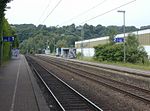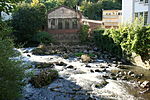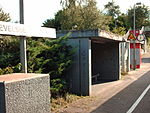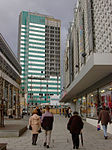Cabinentaxi, sometimes Cabintaxi in English, was a German people mover development project undertaken by Demag and Messerschmitt-Bölkow-Blohm with funding and support from the Bundesministerium für Forschung und Technologie (BMFT, the German Ministry of Research and Development). Cabinentaxi was designed to offer low-cost mass transit services where conventional systems, like a metro, would be too expensive to deploy due to low ridership or high capital costs.
Cabinentaxi systems could be operated in a variety of fashions depending on the need. It is most widely known as the first true personal rapid transit (PRT) system, where customers call up a small "car" on demand which then takes them directly to their destination without any stops along the way. The system could also be used in a group rapid transit (GRT) fashion, using larger cars with up to 18 passengers. In this case the vehicles would travel along a fixed route, stopping at any station that a passenger requested. Cabinentaxi could also mix the two modes on a single line, which allowed direct routing to high-density areas when traffic loads were low, saving the larger van-like vehicles for the high-demand periods.
Cabinentaxi was in serious consideration for two deployments in the late 1970s; BMFT was in the process of funding a deployment in Hamburg while their U.S. counterpart, the Urban Mass Transit Authority (UMTA), selected it as a front-runner for a deployment in Detroit. Cabinentaxi's corporate partners decided to pull out of the Detroit competition to focus on the Hamburg development. When unrelated budget cuts drained the BMFT's coffers, the Hamburg project was also canceled, and the Cabintaxi Joint Venture gave up on the public transit field and withdrew the Cabintaxi technology from the market. The rights were purchased in 1985 by a small U.S. consortium, Cabintaxi Corporation, but no developments have followed. The only commercial use was a modified system, the Cabinlift, which operated as a horizontal elevator between buildings at the Schwalmstadt-Ziegenhain hospital in Germany until 2002.











